Godzilla: 3, Castles: 0 – The History of the Castles Godzilla Wrecked
The city of Washington, DC has taken occasional issue with production companies shooting large-scale action and science-fiction movies in the National Mall. As one government official explained, in regards to a planned shoot for the third Transformers film, “The National Mall is not an area in which Americans come to see high-tech action movies being made.”
What? That’s one of the reasons we have national monuments! This is not a defense of Transformers 3: We Won’t Get It Right Until Bumblebee, but a reminder that one of the core purposes of great landmarks across the globe is so they can be destroyed by aliens, robots, and giant monsters on the big screen.
Giant monsters in particular love wrecking landmarks, or at least getting good spectacle use out of them (such as Kong and the Empire State Building). Watching a titanic creature devastate a familiar cultural object provides a sinister thrill for viewers; it makes the monster that much more intimidating. Your human-sized buildings, no matter their age or importance to national psyche, mean nothing to these beasts.
The Japanese breed of giant monsters, kaijus, have devastated bridges, skyscrapers, dams, baseball stadiums, and almost anything else built in contemporary Japan. But one landmark has a special place in kaiju disrespect for infrastructure and culture: the feudal castle. The first castle Godzilla destroyed was in the second movie of the series, Godzilla Raids Again. This worked so well that the next two movies also had castle destructions that have turned into some of the most famous Godzilla moments.
Most folks outside of Japan are unfamiliar with the history of these castles, let alone know them by name. In my love of cross-disciplinary exercises, I’ve put together a history guide to those first three castles to fall under the force of the Big G, either solo or while beating up another monster. This is one of my personal loves about Godzilla: using the monster as a springboard to other subjects I might not have gotten around to otherwise. Like origami.
Osaka Castle (Godzilla Raids Again, 1955)
The Battle of Osaka Castle is one of the key monster fights in Japanese film history, because it was the original one. Godzilla faced an opponent monster for the first time in Godzilla Raids Again — a landmark fight that destroyed a landmark.
Osaka Castle (Osaka-jo), located in Japan’s second largest city, is one of the country’s great castles, although it’s gone through tough times and most of what you can see today is from a 1931 ferro-concrete renovation-reconstruction. World War II bombing added another disaster onto the renovation, and it was re-renovated in 1995 and 1997.
Construction on the original castle started in 1583 during the second half of the Sengoku Period, a.k.a. “The Warring States Period.” This is when the Japanese feudal system collapsed and ended the rule of the Ashikaga Shogunate, which had governed the country since 1338. The warlord Oda Nobunaga, the first of the “three unifiers” of Japan, drove away the shogunate in 1573 during the Ishiyama Hongan-ji War where Nobunaga seized the power base of a rebellious religious faction. The power base was in a cathedral fortress in Osaka, which surrendered to Nobunaga in 1580 after a long siege. The fortress was burnt down, and three years later Nobunaga’s successor Toyotomi Hideyoshi (second of the unifiers) started work on the new castle to help secure his ambitions to make Osaka the center of a unified Japan.
The castle didn’t stay in prime shape for long. Hideyoshi died in 1598, and in 1615 troops of the Tokugawa clan destroyed the castle after a two-year siege of the city. This ended the Toyotomi lineage, replacing it with the Tokugawa Shogunate—a bit more on them later. Of course, the Tokugawa clan wasn’t going to allow a fantastic strategic castle location to go to waste, and Tokugawa Hidetada, second shogun of the dynasty, started rebuilding it in the 1620s.
Nature had its way with the castle in 1665 (apparently as a primer for burning London the next year), when a lightning bolt struck the main tower and burnt it down. Repairs weren’t made until 1843—and then it got torched again in 1868 during a fight between the New Government Army and the Tokugawa Shogunate. The shoguns fled, and the Meiji government requisitioned the castle area. The castle was converted into the Osaka Army Arsenal. It wasn’t until 1931 that large reconstruction was started.
In 1955, the same year Osaka Castle was recognized as a Special Historic Site by the Japanese government, the biggest disaster in the castle’s history occurred. A second Godzilla, recently discovered on an island, was drawn into Osaka because of an accidental oil tanker explosion. Godzilla engaged in a fight with a large quadruped creature, Anguirus, and the two smashed through the city center. Godzilla hurled Anguirus into Osaka Castle and demolished the building in seconds, making the Tokugawa clan look like chumps. Anguirus’s body fell into the Okawa River beside the castle, where Godzilla killed it with a bite to the neck, then roasted the body with a radioactive blast. (The US version, Gigantis the Fire Monster, cut out the radioactive blasts because the US version sucks.)
Mysteriously, the castle was intact the next day.
The intricate model of Osaka Castle built for Godzilla Raids Again was two meters tall, and its destruction was planned as the equivalent of the spectacle of the destruction of the Diet Building in Godzilla. The crew had extra space to construct the model and grounds around it at the new Soundstage #8 at Toho. The castle was built a bit too well: technicians pulled on wires attached to the inside of the model to help it collapse when the monsters bashed into it. But on the first take, neither the monsters nor the crew managed to make the model fall—until the cameras were shut off, and the crew who hadn’t heard “cut!” finally managed to yank the structure down. The castle model had to be rebuilt and the scene shot again.
This is the only of these castles I’ve seen in person. I took a trip to Japan when I was in eighth grade. This was the first historical location we visited on the trip, so I have strong memories of it. At that time, I didn’t know it had suffered Godzilla devastation because Godzilla Raids Again had not yet been released in the US and Gigantis the Fire Monster had long vanished from the airwaves.
Atami Castle (King Kong vs. Godzilla, 1962)
Godzilla and Anguirus wrecked Osaka Castle 370 years after it was built. Godzilla and King Kong destroyed Atami Castle three years after it was built. Yes, Atami Castle isn’t a genuine feudal castle at all, but an EPCOT-style tourist attraction imitating one. Like a fake Wild West town.
So there isn’t much history to talk about—although this is the only castle that hasn’t needed reconstruction because of armies sacking it or wartime bombing. Tourism was booming in Japan during the late 1950s as the country entered a period of massive economic growth expanding beyond pre-war levels. There’s a reason the giant monster movie classics were coming out in theaters at this time; the Japanese film industry was tremendous and putting out an average of 450 movies into theaters a year.
Building a tourist center shaped like a classic castle in the coastal resort town of Atami must have made sense. The city is partially located in the National Park for Mt. Fuji and contains numerous hot springs, making it a top destination for both domestic and international visitors. The declaration of the city by the government as an International Tourism and Culture City in 1950 sped up tourist development, leading to the creation of Atami Castle.
Along with a museum of Samurai culture, the castle contains (according to one tourist website for Atami) “a ukiyo-e printing museum, a photo corner where you can put on costumes and dress up like a samurai or princess. Be sure to take advantage of the experience to set back in time by trying on a samurai costume guaranteed to be fun.” The top of the tower offers a panoramic 360° view, and one of the best spots to see cherry blossoms in spring. I’d much rather see an actual historical castle, but if the kids have fun and you can get some great Instagram pictures …
In 1962, the castle was destroyed when the Japanese government air-dropped the super ape King Kong onto the slopes of Mt. Fuji to attack Godzilla. The two monsters rolled down the side of the mountain and eventually smashed the castle apart trying to get to each other before they both tumbled into the ocean.
Mysteriously, the castle was intact the next day. Godzilla was named an official cultural ambassador for Tokyo in 2015, so the castle and the monster now work together in the same industry.
The destruction of the two-meter model of the castle went smoothly. The castle wasn’t on a soundstage, but built outside next to a large pool on the lot. The switch to shooting in color had pushed effects director Eiji Tsubaraya to film more of the day-time special effects scenes outdoors, which contributed to the authenticity.
Nagoya Castle (Mothra vs. Godzilla, 1964)
Nagoya Castle, located in Japan’s fourth largest city, was the home of the powerful Owari lineage of the Tokugawa clan, whom we’ve already met destroying Osaka Castle—far slower than Godzilla did, thank you very much. The Tokugawa Shogunate ruled over most of Japan from the early seventeenth century until 1868 and have given their name to this period. This is when most samurai movies are set—it’s the Old West of Japanese film.
During the Tokugawa Shogunate, Nagoya was an important post station along two major trade roads. The first parts of the castle, however, were built earlier in 1521 by a military governor, although it was eventually abandoned. In 1609, the founder of the Tokugawa Shogunate, Tokugawa Ieyasu (the third unifier), ordered the reconstruction of the castle. The techniques used on Nagoya castle became the founding ones used throughout the Tokugawa Shogunate for the construction of other castles.
The castle was completed in 1612 and was an architectural and aesthetic marvel encompassing the work of many of the finest artists in Japan. The castle was under almost constant renovations and improvements for over a hundred years, with the addition of turrets and outbuildings and decorations such as a pair of golden dolphins (the kinshachi)—later melted down to pay off a debt and recast over wire frames to save money.
The castle was still in excellent shape when the shogunate came to its end and the Owari lineage submitted to the emperor. Plans were in place to have the castle demolished in the 1870s, but the imperial war minister chose to preserve it on the advice of a colonel and the German minister to Japan. Although partially damaged in an 1891 quake, Nagoya Castle was designated as an official imperial residence. In 1930, the castle passed to the ownership of the city of Nagoya, and a year later it was opened to the general public.
During World War II, the castle served as an administration center for a POW camp and Tokai district army headquarters. In January 1945, Allied bombing destroyed large parts of the castle, although most of the paintings and other national treasures had already been removed and placed in storage.
Reconstruction started in 1957. Many of the treasures were restored to their original place, and the castle was reopened to the public in 1959, complete with reconstructions of the kinshachi. It did not last long. Nagoya Castle was wrecked in 1964 when Godzilla emerged from underground hibernation and headed directly to Nagoya. The monster passed near the castle, but slipped on the edge of the moat, causing its massive body to smash into the main donjon. Godzilla attempted to right itself by grabbing onto the castle, and then in frustration bashed it all to the ground, defying those fantastic architectural methods from the early seventeenth century and possibly ruining many of the greatest art treasures of Japan, because Godzilla don’t give a damn.
Mysteriously, the castle was intact the next day. Dolphins and treasures too. The golden dolphins are now used as symbols of Nagoya.
The third castle destruction was when special effects wizard Eiji Tsuburaya and his team had perfected historical castle demolition. They no longer needed two monsters to commit they deed: Godzilla could do it solo. The result is one of the Five Best Moments in Godzilla History, a great example of a killer set-piece that becomes a work of art. (And, by the way, Mothra vs. Godzilla is my favorite of all Godzilla films.)
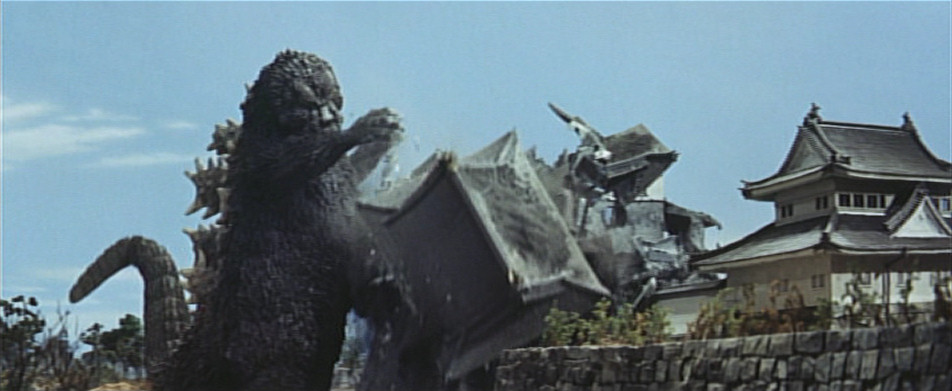
Like the crash of Osaka Castle, the destruction didn’t come off smoothly the first time. The plan was always for stunt performer Haruo Nakajima to slip on the moat and accidentally crash into the castle—this was part of imagining Godzilla as not inherently hostile to its surroundings unless attacked or ticked off. The first time the sequence was shot, the technician behind the castle pushed it too soon, and the castle collapsed before Godzilla reached it. The castle was rebuilt. On the next attempt, Nakajima fell onto the castle as planned, but the model didn’t fall and only suffered damage on its side. Nakajima tried to salvage the take by roaring as if Godzilla was annoyed the structure wasn’t crumbling like everything else the monster runs into. The damage was repaired, and the footage from the fall was combined with a second take, where Godzilla clawed up the castle side and tore it down in the process.
These accidents ended up making the scene play even better. Watching Godzilla get enraged at bumping into the castle, flail away at it trying to get up, and then step back with hands held up as if saying, “Whoa, didn’t know it would be that bad,” is 100% giant monster magic. Huge credit to Nakajima for suit-acting the hell out of this moment.
For the record, here are all the Japanese cities Godzilla has, uhm, visited during the long movie series: Tokyo, Tokai, Osaka, Yokohama, Fukuoka, Nagoya, Kyoto, Tateyama, Sapporo, and Hakone. This can help you put together your own Kaiju Destruction Tourism Package.
Ryan Harvey (RyanHarveyAuthor.com) is one of the original bloggers for Black Gate and has written for the site for over a decade. He received the Writers of the Future Award for his short story “An Acolyte of Black Spires.” His stories “The Sorrowless Thief” and “Stand at Dubun-Geb” are available in Black Gate online fiction. A further Ahn-Tarqa adventure, “Farewell to Tyrn”, is available as an e-book. Ryan lives in Costa Mesa, California. Occasionally, people ask him to talk about Edgar Rice Burroughs or Godzilla.
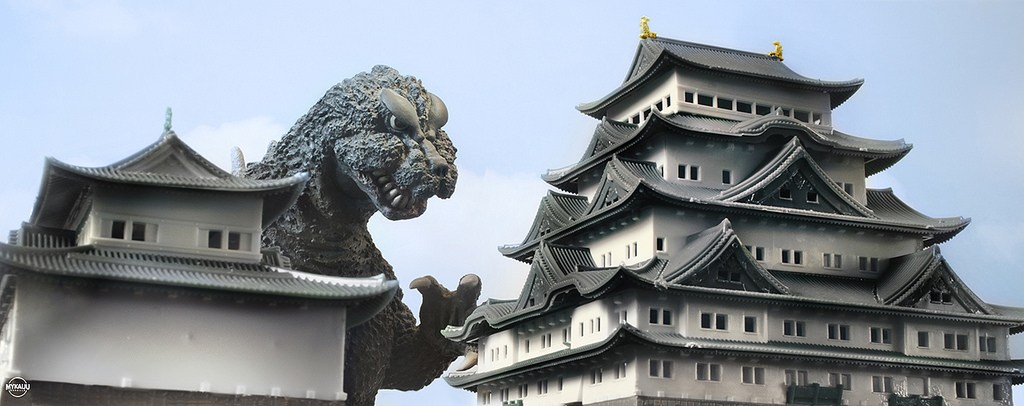
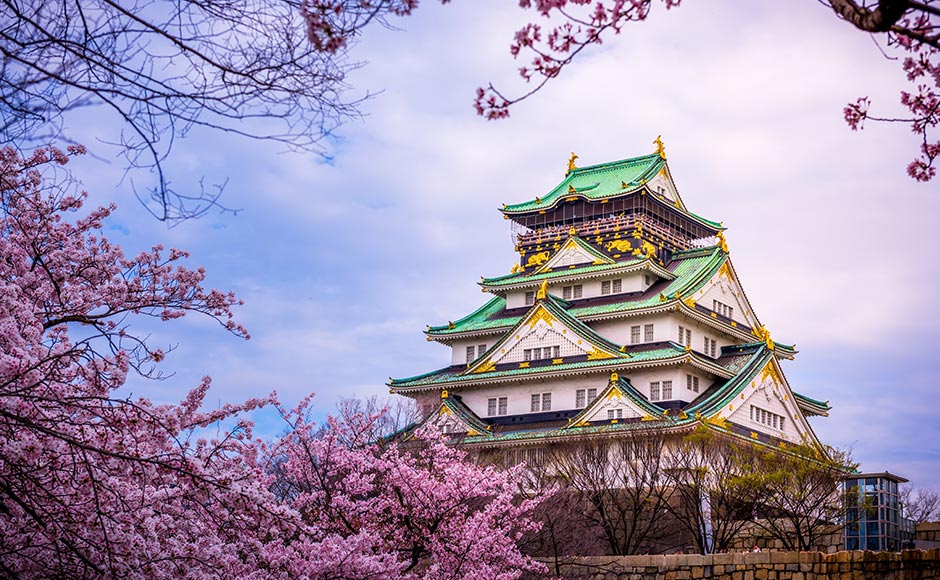
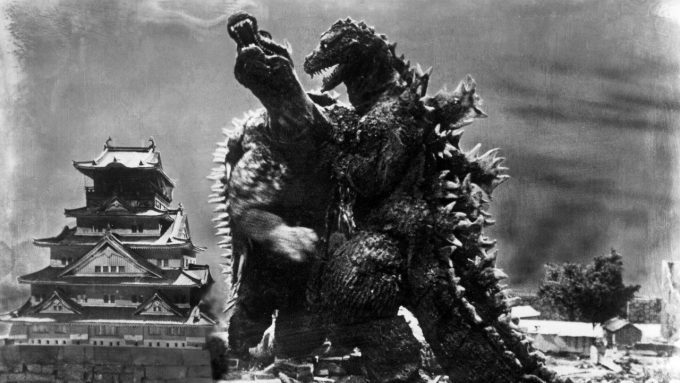
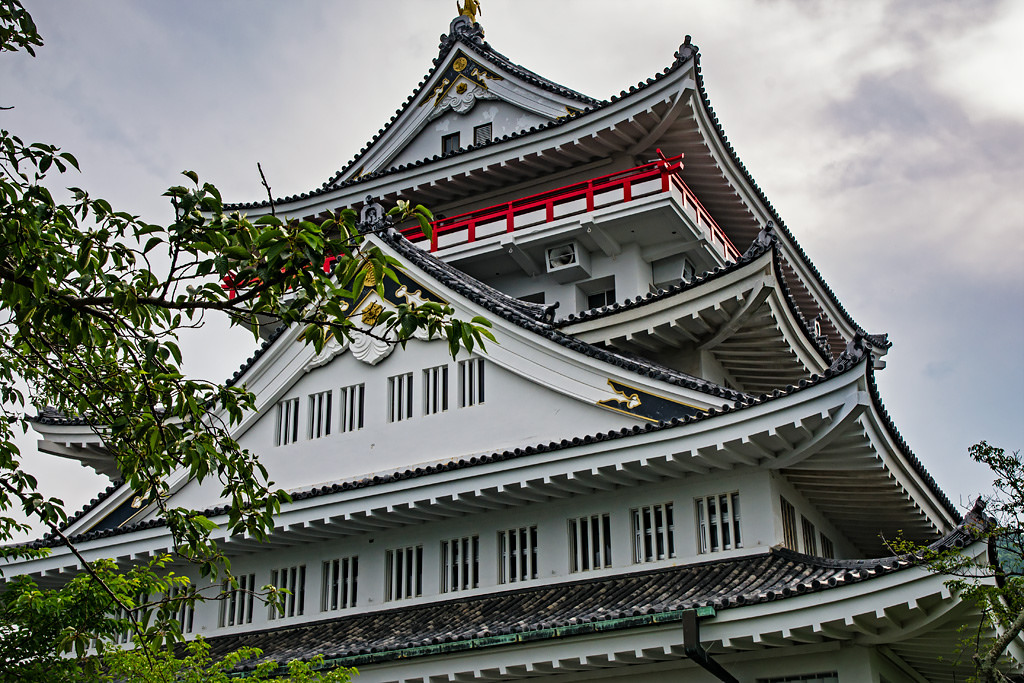
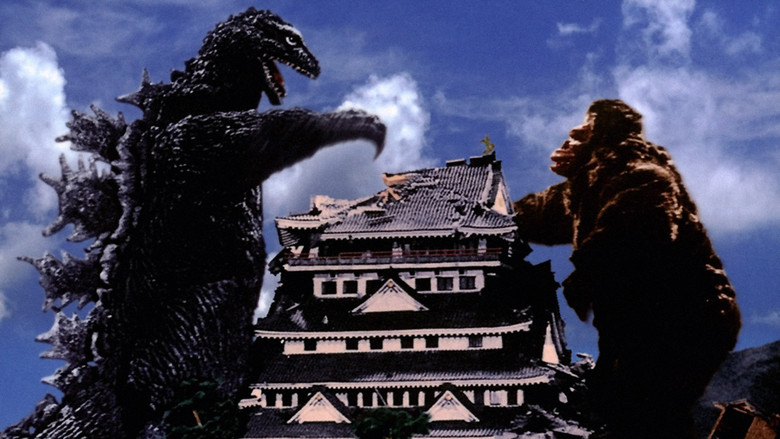
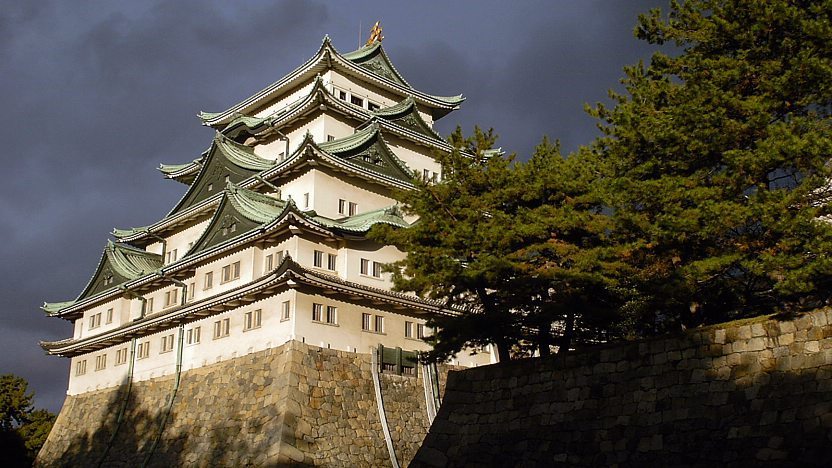
These and the first King Ghidorah are some of the last ones on my list that I need to see. I have a hard time finding the older movies at all or at an affordable price unfortunately.
I went to Osaka Castle in 04, what I remember most for some reason was the huge rock foundation/wall you have to zig zag through on your way to the castle. Quite the approach when youre looking at it from the ground.